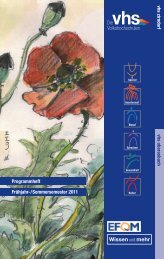Der NEUE Katalog ist da! - PRO PUBLIC GmbH
Der NEUE Katalog ist da! - PRO PUBLIC GmbH
Der NEUE Katalog ist da! - PRO PUBLIC GmbH
You also want an ePaper? Increase the reach of your titles
YUMPU automatically turns print PDFs into web optimized ePapers that Google loves.
5<br />
Services<br />
Mycoplasma<br />
Mycoplasmas are the smallest self breeding prokaryotes.<br />
As they have no cell wall the form of the mycoplasmas is<br />
very variable and they can pass the usual sterile filter (0.2<br />
μm). Contaminations of cell cultures with mycoplasmas<br />
are abun<strong>da</strong>nt and not easy to discover, because they do<br />
not always cause significant effects.<br />
The following detection systems are used :<br />
• Microbial culture. After concentration in special media<br />
under aerobic and anaerobic conditions the assays<br />
are plated on agar plates. After additional incubation<br />
steps a microscopic analysis take place. Mycoplasma<br />
contamination is identifiable by the fried egg form of<br />
the colonies.<br />
• DNA-binding fluorescence colorant (DAPI, bisbencimide).<br />
Contaminations can be detected by colouring the<br />
mycoplasma DNA with special binding fluorochrome<br />
DAPI (4-6-diamidino-2-phenylindol-di-hydrochloride).<br />
Under the fluorescence microscope the mycoplasmas<br />
appear as equally formed, small, bright shining points<br />
or accumulations of them outside the indicator cells<br />
(often at the cell membrane). As the mitochondrial DNA<br />
is coloured only marginally, the background fluorescence<br />
is quite small.<br />
• Detection of mycoplasma specific enzymes. With special<br />
test kits mycoplasma specific enzymes are detected.<br />
• PCR ribosomal RNA. Amplified mycoplasma specific<br />
rRNA segments are separated and detected electrophoreticly.<br />
Virus tests according EMEA guidelines<br />
The following virus tests are performed according to the<br />
EMEA guideline CPMP/BWP/1793/02 (note for gui<strong>da</strong>nce<br />
on the use of bovine serum in the manufacture of human<br />
biological medicinal products) :<br />
• Bluetongue and related orbi viruses<br />
• Bovine adenovirus<br />
• Bovine parvovirus<br />
• Bovine respiratory syncytial virus (BRSV)<br />
• Bovine viral diarrhoea virus (BVDV)<br />
• Rabies virus (rabies)<br />
• Reo virus<br />
• Bovine polyoma virus (BPyV)<br />
Sterility<br />
The absence of bacterial or fungal contaminations is verified<br />
by incubation with Caso-Bouillon or Thioglycolat-Bouillon<br />
according to Pharm. Eur.<br />
Bacterial count<br />
The detection of the total number of viable aerobic germs<br />
will be either done by membrane filtration or plate-flushmethod<br />
or as surface-method. The microorganisms are<br />
detected as colony building units per ml (CBU/ml) on casein<br />
peptone-soy flour peptone-agar plates.<br />
5.3<br />
Dienstle<strong>ist</strong>ungen<br />
Tests for Pathogenic Agents/Erregertestungen<br />
Mycoplasmen<br />
Mycoplasmen sind die kleinsten sich selbst vermehrenden<br />
Prokaryoten. Da sie keine feste Zellwand besitzen sind sie<br />
in ihrer Form sehr variabel und können somit die üblichen<br />
Sterilfilter (0,2μm) passieren. Kontaminationen von Zellkulturen<br />
mit Mycoplasmen sind häufig und oft nicht leicht<br />
zu entdecken, <strong>da</strong> sie nicht immer dramatische Effekte bewirken.<br />
Folgende Detektionssysteme werden angewendet :<br />
• Mikrobielle Kultur. Nach Anreicherung in speziellen<br />
Nährmedien unter aeroben und anaeroben Bedingungen<br />
werden die Proben auf Agarplatten ausplattiert.<br />
Nach weiteren Inkubationsschritten erfolgt die Auswertung<br />
unter dem Mikroskop. Mycoplasmenkontaminationen<br />
sind an der charakter<strong>ist</strong>ischen „Spiegeleiform“<br />
der Kolonien erkennbar.<br />
• DNA-bindende Fluoreszenzfarbstoffe (DAPI, Bisbenzimid).<br />
Kontaminationen können durch die Anfärbung<br />
der Mycoplasmen-DNA mit dem speziell an DNA bindenden<br />
Fluorochrom DAPI (4-6-Diamidino-2-phenylindoldi-hydrochlorid)<br />
festgestellt werden. Die Mycoplasmen<br />
erscheinen als gleichmäßig geformte, kleine, hell leuchtende<br />
Punkte oder Ansammlungen von solchen außerhalb<br />
der Indikatorzellen (me<strong>ist</strong> an der Zellmembran)<br />
unter dem Fluoreszenzmikroskop. Da sich mitochondriale<br />
DNA kaum sichtbar anfärbt, <strong>ist</strong> die Hintergrundfluoreszenz<br />
gering.<br />
• Nachweis mycoplasmaspezifischer Enzyme. Mit einem<br />
Testkit werden mycoplasmaspezifische Enzyme nachgewiesen.<br />
• PCR ribosomaler RNA. Amplifizierte mycoplasmenspezifische<br />
rRNA-Abschnitte werden elektrophoretisch<br />
aufgetrennt und nachgewiesen.<br />
Virus Testungen gemäß EMEA Guidlines<br />
Folgende Viren-Testungen werden nach der EMEA Richtlinie<br />
CPMP/BWP/1793/02 (Note for Gui<strong>da</strong>nce on the use of<br />
bovine serum in the manufacture of human biological<br />
medicinal products) durchgeführt:<br />
• Bluetongue und verwandte Orbiviren<br />
• Bovine Adenovirus<br />
• Bovine Parvovirus<br />
• Bovine Respiratory Syncytial Virus (BRSV)<br />
• Bovine Viral Diarrhoea Virus (BVDV)<br />
• Rabies Virus (Tollwut)<br />
• Reovirus 3<br />
• Bovine Polyoma Virus (BPyV)<br />
Sterilität<br />
Die Abwesenheit von bakteriellen und pilzlichen Kontaminationen<br />
wird durch Bebrütung in Caso-Bouillon bzw. Thioglycolat-Bouillon<br />
nach Pharm. Eur. nachgewiesen.<br />
Keimzahlbestimmung<br />
Die Bestimmung der gesamten lebensfähigen aeroben<br />
Keime erfolgt entweder als Membranfiltrationsverfahren,<br />
als Plattengussverfahren oder als Oberflächenverfahren.<br />
Die Mikroorganismen werden als koloniebildende Einheiten<br />
pro ml (KBE/ml) auf Caseinpepton-Sojamehlpepton-Agar-<br />
Platten detektiert.<br />
BIOTECH <strong>GmbH</strong>





